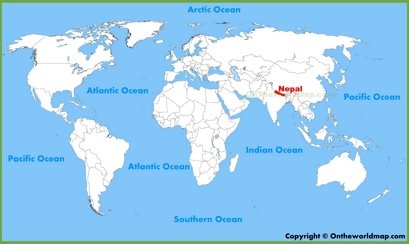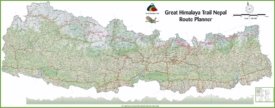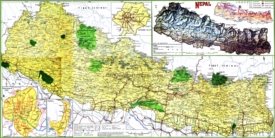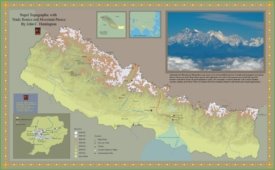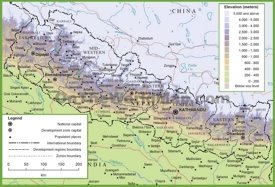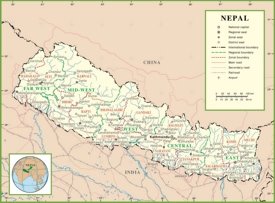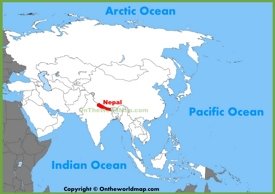Nepal Map
Description:
This map shows governmental boundaries of countries; provinces, province capital cities, and major cities and towns in Nepal.
Size: 1800x1319 / 399 Kb
Author: Ontheworldmap.com
Previous versions of the map (2021): 1400x1024 / 253 Kb | 1800x1317 / 380 Kb
You may download, print or use the above map for educational, personal and non-commercial purposes. Attribution is required. For any website, blog, scientific research or e-book, you must place a hyperlink (to this page) with an attribution next to the image used.
Online Map of Nepal
About Nepal
Nepal, officially the Federal Democratic Republic of Nepal, occupies 56,956 square miles (147,516 square kilometers) in South Asia, positioned between India and China's Tibet Autonomous Region. The country contains eight of the world's ten tallest mountains, including Mount Everest, which reaches 29,029 feet (8,848 meters).
Nepal's population stands at approximately 31.1 million people (2024 estimate). Kathmandu, the capital and largest city, houses 1.4 million residents and serves as the country's political, economic, and cultural hub. Other major cities include Pokhara, Lalitpur, and Bharatpur. The official language is Nepali, though the nation recognizes 123 languages spoken by various ethnic groups.
The country's economy relies heavily on agriculture, which employs 65% of the population and contributes 26% to the GDP. Primary crops include rice, corn, wheat, and sugarcane. Remittances from Nepalis working abroad constitute about 30% of the GDP. The industrial sector, including textiles, carpets, and tea processing, represents roughly 13% of the economy.
Tourism plays a vital role in Nepal's economy, with the country attracting over 1.1 million visitors annually before the COVID-19 pandemic. Major attractions include Mount Everest Base Camp, the Annapurna Circuit, and seven UNESCO World Heritage Sites. The ancient cities of Kathmandu Valley - Kathmandu, Bhaktapur, and Patan - feature distinctive architecture and historical monuments. Chitwan National Park, home to Bengal tigers and one-horned rhinoceros, draws wildlife enthusiasts from around the world.
Nepal's geography divides into three distinct regions: the Himalayan region in the north, the central hill region, and the southern Terai plains. This diverse landscape supports various ecosystems and contains over 880 bird species, 650 butterfly species, and numerous rare mammals. The country experiences five seasons: spring, summer, monsoon, autumn, and winter, with the monsoon season occurring from June to September.
The nation transitioned to a federal democratic republic in 2008, ending its 240-year-old monarchy. The government structure includes seven provinces with significant autonomy. Despite challenges like natural disasters and political instability, Nepal continues to develop its infrastructure and tourism sector while working to preserve its natural resources and improve living standards for its population.
The Facts:Capital: Kathmandu.
Area: 56,956 sq mi (147,516 sq km).
Population: ~ 31,122,387 (2024 estimate).
Official language: Nepali.
Currency: Nepalese rupee (Rs, रू) (NPR).
Largest Cities: Kathmandu, Pokhara, Lalitpur, Bharatpur, Birgunj, Biratnagar, Janakpur, Ghorahi, Hetauda, Dhangadhi, Tulsipur, Itahari, Nepalgunj, Butwal, Dharan, Kalaiya, Jitpursimara, Mechinagar, Budhanilkantha, Gokarneshwar.
Provinces of Nepal
| Province | Capital | Area | Population (2021) |
|---|---|---|---|
| Bagmati Province | Hetauda | 7,838 sq mi (20,300 sq km) | 6,084,042 |
| Gandaki Province | Pokhara | 8,303 sq mi (21,504 sq km) | 2,479,745 |
| Karnali Province | Birendranagar | 10,805 sq mi (27,984 sq km) | 1,694,889 |
| Koshi Province | Biratnagar | 10,002 sq mi (25,905 sq km) | 4,972,021 |
| Lumbini Province | Deukhuri | 8,605 sq mi (22,288 sq km) | 5,124,225 |
| Madhesh Province | Janakpur | 3,730 sq mi (9,661 sq km) | 6,126,288 |
| Sudurpashchim Province | Godawari | 7,689 sq mi (19,915 sq km) | 2,711,270 |


